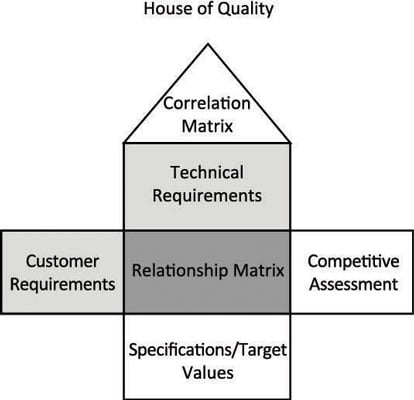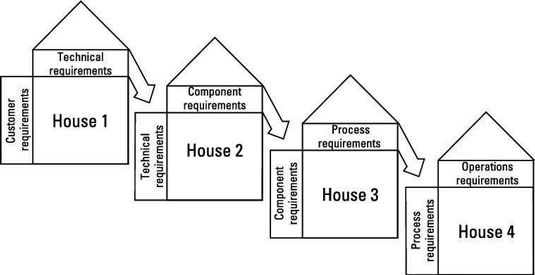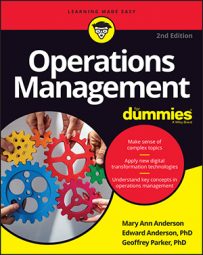Good operations management is essential for quality. Quality begins with a product’s design, which determines how well the product will meet customers’ needs and, to a large extent, drives the cost of production. Therefore, it’s critical that marketing, product design, and manufacturing work together.
Quality function deployment (QFD) is a structured approach for integrating customers’ requirements into a product; it’s also the process used to create the product. The house of quality (HOQ) is a tool to accomplish this integration.
Start with the end in mind
Just as two of the three little pigs learned, if you don’t build a quality house — in the case of these famous pigs, a quality house is one that can survive a wolf’s huffing and puffing! — then you may find yourself without shelter. The same principle of building in quality applies when designing any other product. The HOQ ensures that quality is designed into a product from the start.
When building your house, you want to start with the customer requirements, which are usually called the voice of the customer (VOC). This is what the customer needs and wants from your product. Generally, VOC is expressed in qualitative terms such as, “I want a house that will keep a wolf out.” Later, you put quantitative measures on the requirement: The house must withstand a 100-mph wind gust.

Developing a VOC that captures exactly what your customer expects requires market research and an intimate knowledge of your potential customers. Be aware that some of the customer requirements may conflict with each other. Because of the potential conflicts, ranking requirements based on their importance to the customer is often necessary.
After capturing the VOC, you need to establish the product’s technical requirements — how you’re going to deliver the customers’ wants. These are listed in the top “room” of the house and are general characteristics of the design. For the pigs’ house, technical requirements may be wall thickness and number of windows.
The specifications or target values associated with the technical requirements are detailed in the lowest level of the house. Here, you list quantitative specifications, such as 6 inches for wall thickness and at least 5 windows.
The main room of the house is the relationship matrix; it shows the correlation between each VOC and technical requirements. Typically, four possible conditions exist: strong, medium, small, and negligible. For example, a strong relationship exists between the take-advantage-of-the-mountain-views VOC and the number-of-windows technical requirement. The more windows, the more open the view.
The triangular attic at the top of the house contains the correlation matrix and shows the relationship among the product’s technical requirements. Each requirement can have a negative, strong negative, positive, strong positive, or no relationship with the other requirements. For example, wall thickness has a strong negative relationship with the number of windows because windows are relatively thin, while an insulation requirement has a positive relationship with wall thickness.
The correlation matrix helps identify key requirement conflicts. Product designers must find ways to overcome the conflicts or decide what trade-offs they need to make in the design. In the case of the pigs’ house, the designer may be able to add shutters to the windows that the pigs can open in the absence of the wolf to provide the view, and they can close them when the wolf threatens.
Shutters, however, add to the cost of building the house, which may dissatisfy the customer, especially if cost is one of the important customer requirements.
The last room of the house is the competitive assessment. This room allows you to rank yourself against your prime competitors and highlights weakness in your product. Typically, you want to access your existing product (if one exists) and several other products in the marketplace. You usually gather the measures in this house from customer surveys. The first measure is the importance rating (often displayed in room 1).
This metric has the customers rank each requirement on how important the requirement is to them. The second measure is a satisfaction rating that indicates how satisfied the customer is with the existing products along each requirement. Scales for the measures vary. A typical scale may be 1 to 5 or 1 to 3, with the higher number indicating greater importance or greater satisfaction.
Developing the HOQ requires cross-functional communication among marketing, design, and manufacturing. Marketing must be able to communicate the VOC to the designers, who must translate the requirements into a design with specific metrics that the manufacturing folks can meet.
Cascade to production
Most often, one house isn’t sufficient to translate the VOC down to actual production. You can use QFD to build cascading houses where the technical requirements of one house are transformed into the customer requirements of the next.

Building starts with developing the initial HOQ. You repeat the process by using the first set of technical requirements (product requirements) as the new VOC and then developing a house for the part (or component) requirements. This house assigns the product technical requirements to the component responsible for providing them.
This continues to the process planning house, where the hows from the parts house become the whats for the new one, and a new set of requirements is developed. The final house, using the process requirements as the VOC, provides the manufacturing requirements that are used to produce the product. The end result is a structured way to connect the actual wants of the customer to the manufacturing floor.

